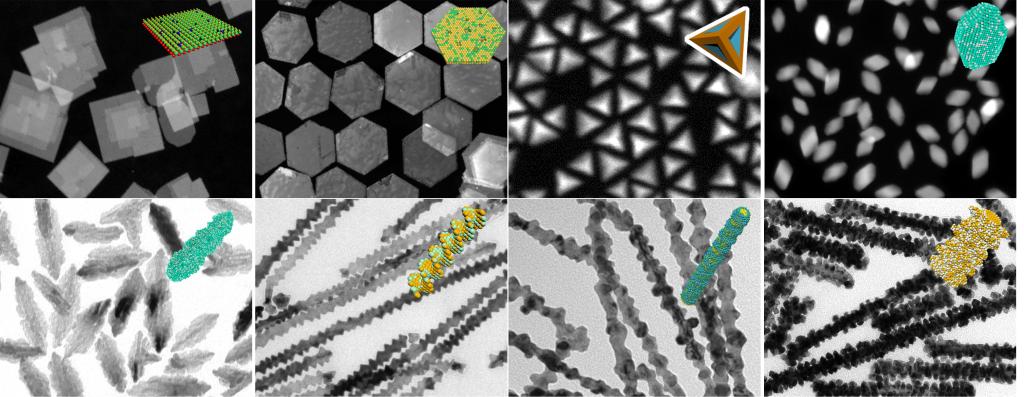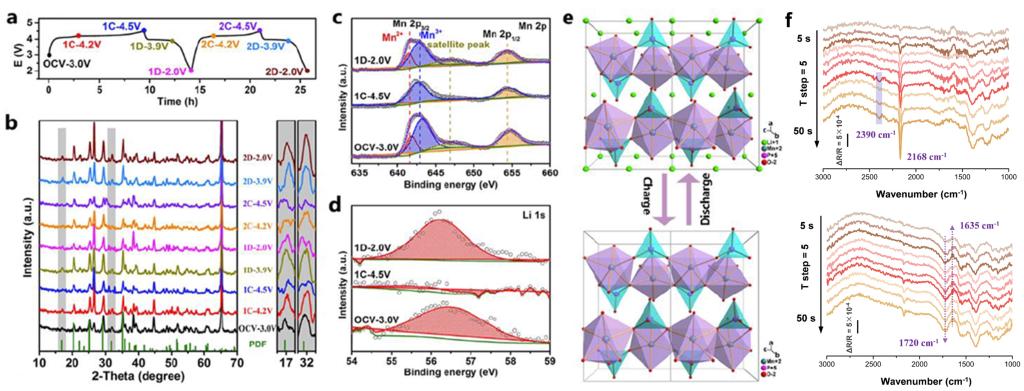|
Nanoenergy Composites
Nanoenergy Composites In the aera of equal importance to energy and environment, new energy materials and devices play an important role in the comprehensive utilization of clean energy, and have become the major demand of current social and economic development and the frontier of science and technology. Our research group has carried out systematic research around the design and synthesis of new energy materials, mechanism research of electrochemical process, new energy storage and converter devices, etc. Important research results have been especially achieved in the design and development of high-efficiency photocatalytic/electrocatalytic materials and devices, Li/Zn secondary batteries, supercapacitors and flexible wearable devices. 1. Design and synthesis of new energy materials
New energy nanomaterials with controllable composition, size, crystal structure and surface microstructure were designed and synthesized through small molecule regulation and one-pot two-step seed strategy, which lay a theoretical and experimental foundation for the development of new, efficient and stable new energy materials.
2. Mechanism of new energy conversion and storage
In view of the conversion reaction process of new energy such as hydrogen production by electrolysis of water, ammonia production by nitrogen reduction and the storage reaction process of K/Zn secondary battery, we start from the nanoscale and surface structure and use in-situ infrared/Raman spectroscopy and other in-situ characterization methods to reveal the mechanism of new energy materials in the electrochemical reaction process, providing a theoretical basis for its practical application. 3. Energy storage/conversion devices
Aiming at the issues of limited energy-density and poor safety of traditional secondary batteries, "solid-soft combination" and "in-situ coupling" strategies were proposed to design high-performance solid electrolytes and optimize electrode/electrolyte interfaces, thus achieving solid-state battery systems with high safety, high energy-density and low cost.
Representative publications:
1. Y. Z. Zhang, H. Zheng, K. J. Zhou, J. Y. Ye*, K. B. Chu, Z. Y. Zhou, L. S. Zhang*, T. X. Liu*. Conjugated coordination polymer as a new platform for efficient and selective electroreduction of nitrate into ammonia. Adv. Mater. 2023, 35, 2209855. 2. H. J. Li, H. G. Huang, Y. Chen, F. L. Lai, H. Fu, L. S. Zhang, N. Zhang*, S. X. Bai*, T. X. Liu*. High-entropy alloy aerogels: A new platform for carbon dioxide reduction. Adv. Mater. 2023, 35, 2209242. 3. L. Li, J. Meng, X. R. Bao, Y. P. Huang, X. P. Yan, H. L. Qian, C. Zhang*, T. X. Liu*. Direct-ink-write 3D printing of programmable micro-supercapacitors from MXene-regulating conducting polymer inks. Adv. Energy Mater. 2023, 13, 2203683. 4. Z. H. Shi, S. L. Chen*, Z. J. Xu, Z. M. Liu, J. H. Guo, J. Yin, P. W. Xu, N. Zhang, W. L. Zhang*, H. N. Alshareef*, T. X. Liu*. Metal oxide aerogels: A new horizon for stabilizing anodes in rechargeable zinc metal batteries. Adv. Energy Mater. 2023, 13, 2300331. 5. F. L. Lai, J. J. Huang*, X. F. Liao, W. Zong, L. F. Ge, F. Gan, Y. T. Fang, Y. E. Miao, J. Hofkens*, T. X. Liu*, L. M. Dai*. Semicrystalline conjugated polymers with well-defined active sites for nitrogen fixation in a seawater electrolyte. Adv. Mater. 2022, 34, 2201853. 6. H. Fu, N. Zhang*, F. L. Lai, L. S. Zhang, S. L. Chen, H. J. Li, K. Z. Jiang, T. Zhu, F. P. Xu, T. X. Liu*. Surface-regulated platinum-copper nanoframes in electrochemical reforming of ethanol for efficient hydrogen production. ACS Catal. 2022, 12, 11402-11411. 7. G. J. Chao, Y. Z. Zhang, L. S. Zhang*, W. Zong, N. Zhang, T. T. Xue, W. Fan, T. X. Liu, Y. Xie*. Nitrogen-coordinated single-atom catalysts with manganese and cobalt sites for acidic oxygen reduction. J. Mater. Chem. A 2022, 10, 5930. 8. L. Li, Y. Zhang, H. Lu, Y. Wang, J, Xu, J. Zhu, C. Zhang*, T. X. Liu*. Cryopolymerization enables anisotropic polyaniline hybrid hydrogels with superelasticity and highly deformation-tolerant electrochemical energy storage. Nat. Commun. 2020, 11, 62. 9. F. L. Lai, N. Chen, X. B. Ye, G. J. He, W. Zong, K. B. Holt, B. Pan, I. P. Parkin, T. X. Liu*, R. J. Chen*. Refining energy levels in ReS2 nanosheets by low-valent transition-metal doping for dual-boosted electrochemical ammonia/hydrogen production. Adv. Funct. Mater. 2020, 30, 1907376. 10. F. L. Lai, W. Zong, G. J. He, Y. Xu, H. W. Huang, B. Weng, D. W. Rao*, J. A. Martens, J. Hofkens, I. P. Parkin*, T. X. Liu*. N2 electroreduction to NH3 via selenium vacancy-rich ReSe2 catalysis at an abrupt interface. Angew. Chem. Int. Ed., 2020, 59, 13320-13327. 11. F. L. Lai, J. R. Feng, X. B. Ye, W. Zong, G. J. He*, C. Yang, W. Wang, Y. E. Miao, B. Pan, W. S. Yan, T. X. Liu*, I. P. Parkin*. Oxygen vacancy engineering in spinel-structured nanosheet wrapped hollow polyhedra for electrochemical nitrogen fixation under ambient conditions. J. Mater. Chem. A, 2020, 8, 1652. 12. M. K. Liu, P. Zhang, Z. H. Qu, Y. Yan, C. Lai*, T. X. Liu*, S. Q. Zhang*. Conductive carbon nanofiber interpenetrated graphene architecture for ultra-stable sodium ion battery. Nat. Commun., 2019, 10, 3917. 13. F. L. Lai, J. R. Feng, X. B. Ye, W. Zong, G. J. He, Y. E. Miao*, X. M. Han, X. Y. Ling, I. P. Parkin, B. C. Pan, Y. F. Sun*, T. X. Liu*. Energy level engineering in transition-metal doped spinel-structured nanosheets for efficient overall water splitting. J. Mater. Chem. A, 2019, 7, 827. 14. H. Y. Lu, Y. F. Zhang, Y. P. Huang, C. Zhang*, T. X. Liu*. Reaction packaging CoSe2 nanoparticles in N doped carbon polyhedra with bifunctionality for overall water splitting. ACS Appl. Mater. Interfaces, 2019, 11, 3372. 15. H. L. Guo, Q. C. Feng, J. X. Zhu, J. S. Xu, Q. Q. Li, S. L. Liu, K. W. Xu, C. Zhang*, T. X. Liu*. Cobalt nanoparticle-embedded nitrogen-doped carbon/carbon nanotube frameworks derived from a metal–organic framework for tri-functional ORR, OER and HER electrocatalysis. J. Mater. Chem. A, 2019, 7, 3664. 16. X. F. Wang, Y. M. Qian, L. N. Wang*, H. Yang, H. L. Li, Y. Zhao,* T. X. Liu*. Sulfurized polyacrylonitrile cathodes with high compatibility in both ether and carbonate electrolytes for ultrastable lithium–sulfur batteries. Adv. Funct. Mater. 2019, 29, 1902929. 17. Y. F. Wang, K. Wang, C. Zhang*, J. X. Zhu, J. S. Xu*, T. X. Liu*. Solvent-exchange strategy toward aqueous dispersible MoS2 nanosheets and their nitrogen-rich carbon sphere nanocomposites for efficient lithium/sodium ion storages. Small, 2019, 15, 1903816. 18. G. Y. Zhou, Y. E. Miao*, Z. X. Wei, L. L. Mo, F. L. Lai, Y. Wu, J. M. Ma*, T. X. Liu*. Bio-inspired micro/nanofluidic ion transport channels for organic cathodes in high-rate and ultra-stable lithium/sodium-ion batteries. Adv. Funct. Mater., 2018, 28, 1804629. 19. W. Zong, F. L. Lai*, G. J. He, J. R. Feng, W. Wang, R. Q. Lian, Y. E. Miao, G. C. Wang, I. P. Parkin, T. X. Liu*. Sulfur-deficient bismuth sulfide/nitrogen-doped carbon nanofibers as advanced free-standing electrode for asymmetric supercapacitors. Small, 2018, 14, 1801562. 20. L. Li, K. Wang, Z. Huang, C. Zhang*, T. X. Liu*. Highly ordered graphene architectures by duplicating melamine sponges as a three-dimensional deformation-tolerant electrode. Nano Research, 2016, 9, 2938.
|





